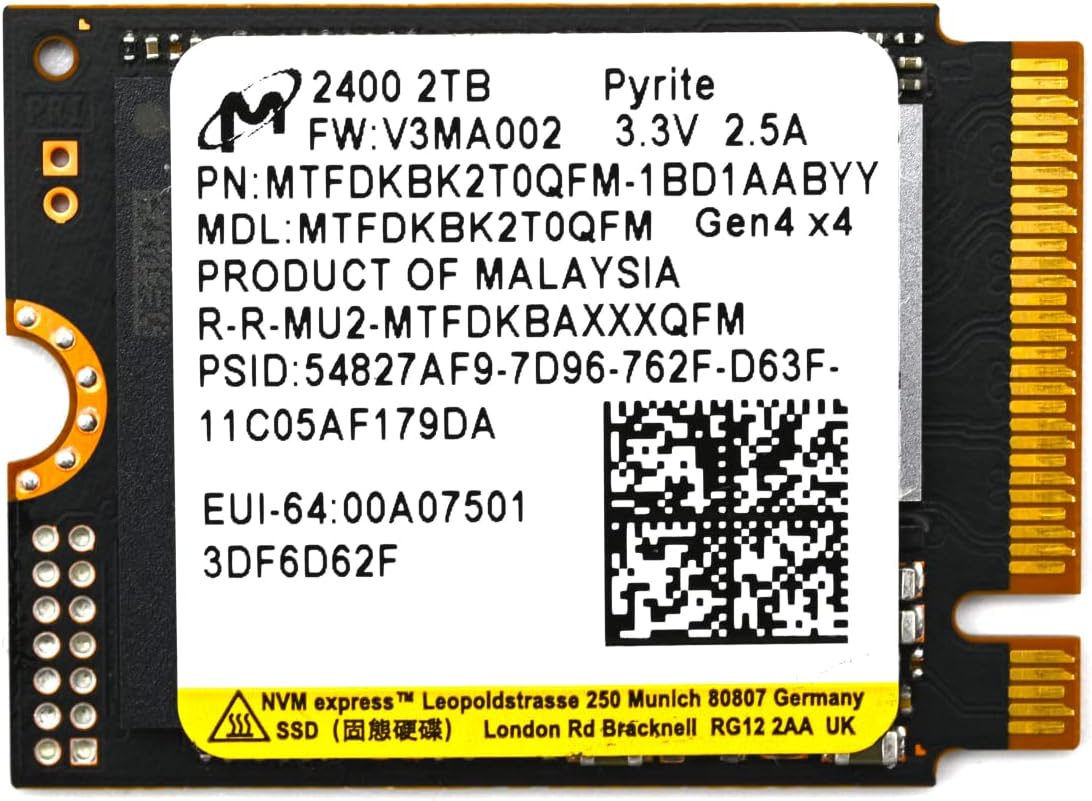
Micron 2TB 2400 M.2 2230 NVMe PCIe 4.0x4 SSD MTFDKBK2T0QFM-1BD1AABYYR
FREE Shipping
Micron 2TB 2400 M.2 2230 NVMe PCIe 4.0x4 SSD MTFDKBK2T0QFM-1BD1AABYYR
- Brand: Unbranded

Description
We use the Quarch HD Programmable Power Module to gain a deeper understanding of power characteristics. Idle power consumption is an important aspect to consider, especially if you're looking for a laptop upgrade as even the best ultrabooks can have mediocre storage. It's worth noting also that the installation process is a little fiddly, but perfectly achieveable with a little patience and this handy iFixit guide that explains it all. Official write specifications are only part of the performance picture. Most SSDs implement a write cache, which is a fast area of (usually) pseudo-SLC programmed flash that absorbs incoming data. Sustained write speeds can suffer tremendously once the workload spills outside of the cache and into the "native" TLC or QLC flash.
Watch the latest DF Weekly, where Digital Foundry staff discuss the hottest gaming technology news.
What's An "Indie Game", Anyway?
This drive is available in a wide range of capacities, with the largest being the 1TB model we've linked here, but if you want to go smaller for whatever reason, Sabrent also offers 256GB and 512GB options. Idle power consumption is higher, but this is with the best power management features disabled, reflecting desktop rather than mobile device use. Most NVMe drives will idle with very little power usage in a laptop or other battery-dependent device, so load power consumption is technically more relevant. However, most of the time the storage will be in lower power states, such that the impact on battery life is minimal.
It would be interesting to try testing this. Like, a decent SSD and controller should write initially to the pSLC cache, but if it's only at ~40 MB/s, the cache can then be immediately flushed to QLC and would perhaps never fill up (until the SSD is completely full). The problem is that writing even 100GB of data at 40 MB/s takes a while, about 40 minutes. I guess that would be the question: if write speeds are slow, like sub-100 MB/s, do the SSDs even use their pSLC caches, or do they just write straight to TLC/QLC NAND?Yup, it's at that point when you want to start reading the controller's source code.
Apple cancelled this, now what?
What I really want is a local shared Steam cache on my 10Gbit LAN, only one copy of every game in a houshold with nearly 10 Steam devices of various kinds. Note that with a 2TB SSD, the pSLC cache could be up to 500GB in size for a completely empty drive. So, if you could do sustained writes at max speed and fill that up, and then had to drain it at ~100 MB/s, it could take over 1.38 hours just to empty the pSLC to QLC. LOL. (Related: The drives take a while to recover in our Windows testing, unless you just wipe/format them.)
Powering off (via a hard switch) in the middle of doing anything can be bad. Most drives limit how much stuff sits in volatile storage (RAM caches) for exactly this reason. High-end drives would have a super capacitor to store power so that they can flush things from RAM to NAND in the event of a power loss. For consumer drives, it's possible, if you cycle the power in the middle of writes, to kill an SSD. Probably very unlikely, and it would depend on the model, but I know in the past I heard of this happening.I had ARK running once on Linux: It loaded ARK faster from a hard disk than Windows loaded it from NVMe... abufrejoval said:I guess the biggest question is: how do you ensure it's done steady-state processing before you turn the device off? I guess even if the OS isn't really needed running, the OS will decide to put the SSD into sleep state and there is very little the SSD can do without risking to have its juice cut off, should it try to refuse.
- Fruugo ID: 258392218-563234582
- EAN: 764486781913
-
Sold by: Fruugo
